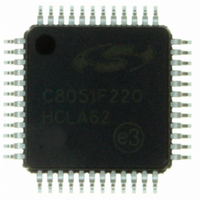C8051F220-GQ Silicon Laboratories Inc, C8051F220-GQ Datasheet - Page 100

C8051F220-GQ
Manufacturer Part Number
C8051F220-GQ
Description
IC 8051 MCU 8K FLASH 48TQFP
Manufacturer
Silicon Laboratories Inc
Series
C8051F2xxr
Specifications of C8051F220-GQ
Program Memory Type
FLASH
Program Memory Size
8KB (8K x 8)
Package / Case
48-TQFP, 48-VQFP
Core Processor
8051
Core Size
8-Bit
Speed
25MHz
Connectivity
SPI, UART/USART
Peripherals
Brown-out Detect/Reset, POR, WDT
Number Of I /o
32
Ram Size
256 x 8
Voltage - Supply (vcc/vdd)
2.7 V ~ 3.6 V
Data Converters
A/D 32x8b
Oscillator Type
Internal
Operating Temperature
-40°C ~ 85°C
Processor Series
C8051F2x
Core
8051
Data Bus Width
8 bit
Data Ram Size
256 B
Interface Type
SPI/UART
Maximum Clock Frequency
25 MHz
Number Of Programmable I/os
32
Number Of Timers
3
Operating Supply Voltage
2.7 V to 3.6 V
Maximum Operating Temperature
+ 85 C
Mounting Style
SMD/SMT
3rd Party Development Tools
PK51, CA51, A51, ULINK2
Development Tools By Supplier
C8051F206DK
Minimum Operating Temperature
- 40 C
On-chip Adc
32-ch x 8-bit
Lead Free Status / RoHS Status
Lead free / RoHS Compliant
For Use With
336-1241 - DEV KIT F220/221/226/230/231/236
Eeprom Size
-
Lead Free Status / Rohs Status
Lead free / RoHS Compliant
Other names
336-1238
Available stocks
Company
Part Number
Manufacturer
Quantity
Price
Company:
Part Number:
C8051F220-GQ
Manufacturer:
Silicon Laboratories Inc
Quantity:
10 000
Company:
Part Number:
C8051F220-GQR
Manufacturer:
Silicon Laboratories Inc
Quantity:
10 000
C8051F2xx
13.1. External Crystal Example
If a crystal were used to generate the system clock for the MCU, the circuit would be as shown in
Figure 13.1, Option 1. For an ECS-110.5-20-4 crystal, the resonate frequency is 11.0592 MHz, the intrin-
sic capacitance is 7 pF, and the ESR is 60 W. The compensation capacitors should be 33 pF each, and
the PWB parasitic capacitance is estimated to be 2 pF. The appropriate External Oscillator Frequency
Control value (XFCN) from the Crystal column in the table in SFR Definition 13.2 (OSCXCN Register)
should be 111b.
The Crystal Oscillator Valid Flag (XTLVLD in register OSCXCN) is set to logic 1 by hardware when the
external oscillator is running and stable. The XTLVLD detection circuit requires a startup time of at least
1ms between enabling the oscillator and checking the XTLVLD flag. Switching to the external oscillator
before 1ms can result in unpredictable behavior. The recommend procedure is:
Switching to the external oscillator before the crystal oscillator has stabilized could result in unpredictable
behavior.
NOTE: Crystal oscillator circuits are quite sensitive to PCB layout. The crystal should be placed as close
as possible to the XTAL pins on the device, keeping the traces as short as possible and shielded with
ground plane from any other traces which could introduce noise or interference.
13.2. External RC Example
If an external RC network were used to generate the system clock for the MCU, the circuit would be as
shown in Figure 13.1, Option 2. The capacitor must be no greater than 100 pF, but using a very small
capacitor will increase the frequency drift due to the PWB parasitic capacitance. To determine the required
External Oscillator Frequency Control value (XFCN) in the OSCXCN Register, first select the RC network
value to produce the desired frequency of oscillation. If the frequency desired is 100 kHz, let R = 246 kW
and C = 50 pF:
13.3. External Capacitor Example
If an external capacitor were used to generate the system clock for the MCU, the circuit would be as shown
in Figure 13.1, Option 3. The capacitor must be no greater than 100 pF, but using a very small capacitor
will increase the frequency drift due to the PWB parasitic capacitance. To determine the required External
Oscillator Frequency Control value (XFCN) in the OSCXCN Register, select the capacitor to be used and
find the frequency of oscillation from the equations below. Assume V
If a frequency of roughly 90kHz is desired, select the K Factor from the table in SFR Definition 13.2 as KF
= 13:
Therefore, the XFCN value to use in this example is 011.
100
1. Enable the external oscillator
2. Wait 1 ms
3. Poll for XTLVLD '0' ==> '1'
4. Switch to the external oscillator
f = 1.23(103)/RC = 1.23(103) / [246 x 50] = 0.1 MHz = 100 kHz
XFCN ³ log2(f/25 kHz)
XFCN ³ log2(100 kHz/25 kHz) = log2(4)
XFCN ³ 2, or code 010
f = KF / (C x V
f = KF / 150
f = 13 /150 = 0.087 MHz, or 87 kHz
DD
) = KF / (50 x 3)
Rev. 1.6
DD
= 3.0 V and C = 50 pF:











